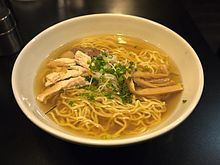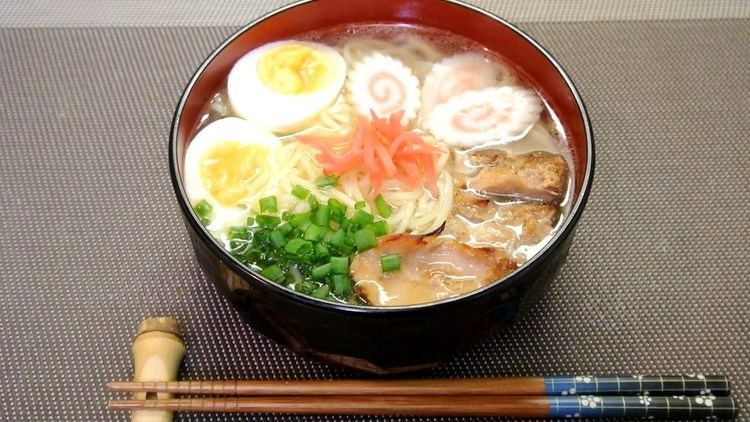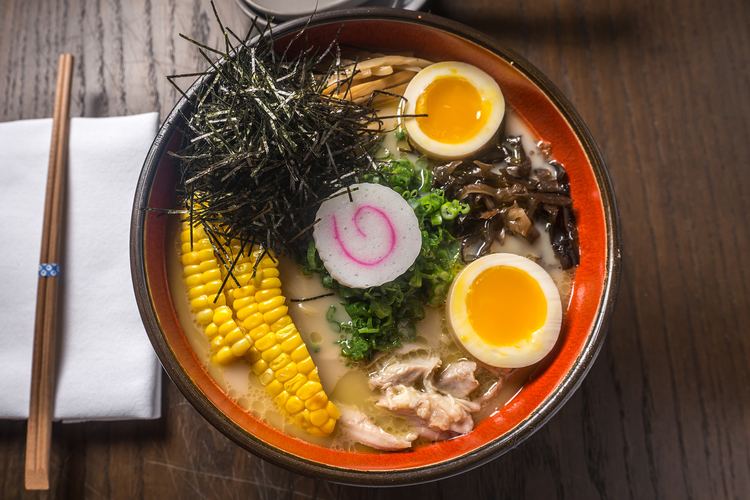Place of origin Japan | Serving temperature Hot | |
 | ||
Variations Many variants, especially regional, with various ingredients and toppings Similar | ||
Ramen recipe japanese cooking 101
Ramen (/ˈrɑːmən/) (ラーメン, rāmen, [ɽaꜜːmeɴ]) is a Japanese dish. It consists of Chinese-style wheat noodles served in a meat- or (occasionally) fish-based broth, often flavored with soy sauce or miso, and uses toppings such as sliced pork (チャーシュー, chāshū), dried seaweed (海苔, nori), menma (メンマ, menma), and green onions (葱, negi). Nearly every region in Japan has its own variation of ramen, from the tonkotsu (pork bone broth) ramen of Kyushu to the miso ramen of Hokkaido.
Contents
- Ramen recipe japanese cooking 101
- Extremely graphic 5 star lobster ramen dish
- History
- Types
- Noodles
- Soup
- Flavors
- Toppings
- Preference
- Regional variations
- Related dishes
- Restaurants in Japan
- Outside Japan
- Instant ramen
- Museum
- Canned version
- Tampopo
- The Ramen Girl
- Ramen Fighter Miki
- References

Extremely graphic 5 star lobster ramen dish
History

The origin of ramen is unclear. Some sources say it is of Chinese origin. Other sources say it was invented in Japan in the early 20th century.

The name ramen is the Japanese pronunciation of the Chinese lamian (拉麵). Until the 1950s, ramen was called shina soba (支那そば, literally "Chinese soba") but today chūka soba (中華そば, also meaning "Chinese soba") or just Ramen (ラーメン) are more common, as the word "支那" (shina, meaning "China") has acquired a pejorative connotation.

By 1900, restaurants serving Chinese cuisine from Canton and Shanghai offered a simple ramen dish of noodles (cut rather than hand-pulled), a few toppings, and a broth flavored with salt and pork bones. Many Chinese living in Japan also pulled portable food stalls, selling ramen and gyōza dumplings to workers. By the mid-1900s, these stalls used a type of a musical horn called a charumera (チャルメラ, from the Portuguese charamela) to advertise their presence, a practice some vendors still retain via a loudspeaker and a looped recording. By the early Shōwa period, ramen had become a popular dish when eating out.
According to ramen expert Hiroshi Osaki, the first specialized ramen shop opened in Yokohama in 1910.

After World War II, cheap flour imported from the United States swept the Japanese market. At the same time, millions of Japanese troops had returned from China and continental East Asia from their posts in the Second Sino-Japanese War. Many of these returnees had become familiar with Chinese cuisine and subsequently set up Chinese restaurants across Japan. Eating ramen, while popular, was still a special occasion that required going out.
In 1958, instant noodles were invented by Momofuku Ando, the Taiwanese-Japanese founder and chairman of Nissin Foods, now run by his son Koki Ando. Named the greatest Japanese invention of the 20th century in a Japanese poll, instant ramen allowed anyone to make an approximation to this dish simply by adding boiling water.
Beginning in the 1980s, ramen became a Japanese cultural icon and was studied around the world from many perspectives. At the same time, local varieties of ramen were hitting the national market and could even be ordered by their regional names. A ramen museum opened in Yokohama in 1994.
Types
A wide variety of ramen exists in Japan, with geographical and vendor-specific differences even in varieties that share the same name. Ramen can be broadly categorized by its two main ingredients: noodles and broth.
Noodles
Most noodles are made from four basic ingredients: wheat flour, salt, water, and kansui (かん水) (from kansui (鹹水, salt water)) a type of alkaline mineral water, containing sodium carbonate and usually potassium carbonate, as well as sometimes a small amount of phosphoric acid.
The kansui is the distinguishing ingredient in ramen noodles, and originated in Inner Mongolia, where some lakes contained large amounts of these minerals and whose water is said to be perfect for making these noodles. Making noodles with kansui lends them a yellowish hue as well as a firm texture. Eggs may also be substituted for kansui. Some noodles are made with neither eggs nor kansui and should only be used for yakisoba, as they have a weaker structure and are more prone to soaking up moisture and becoming extremely soft when served in soup.
Ramen comes in various shapes and lengths. It may be thick, thin, or even ribbon-like, as well as straight or wrinkled.
Soup
Ramen soup is generally made from stock based on chicken or pork, combined with a variety of ingredients such as kombu (kelp), katsuobushi (skipjack tuna flakes), niboshi (dried baby sardines), beef bones, shiitake, and onions.
Flavors
The resulting combination is generally divided into five categories. (although new and original variations often make this categorisation less clear-cut) Described from old ones.
Toppings
After basic preparation, ramen can be seasoned and flavored with any number of toppings, including but not limited to:
Preference
Seasonings commonly added to ramen are black pepper, butter, chili pepper, sesame seeds, and crushed garlic. Soup recipes and methods of preparation tend to be closely guarded secrets.
In most of Tonkotsu ramen restaurants also offer a system known as kae-dama (替え玉), where customers who have finished their noodles can request a "refill" (for a few hundred yen more) to be put into their remaining soup.
Regional variations
While standard versions of ramen are available throughout Japan since the Taisho era, the last few decades have shown a proliferation of regional variations. Some of these which have gone on to national prominence are:
Sapporo, the capital of Hokkaido, is especially famous for its ramen. Most people in Japan associate Sapporo with its rich miso ramen, which was invented there and which is ideal for Hokkaido's harsh, snowy winters. Sapporo miso ramen is typically topped with sweetcorn, butter, bean sprouts, finely chopped pork, and garlic, and sometimes local seafood such as scallop, squid, and crab. Hakodate, another city of Hokkaido, is famous for its salt flavored ramen, while Asahikawa in the north of the island offers a soy sauce-flavored variation. In Muroran, many ramen restaurants offer Muroran curry ramen.
Kitakata in northern Honshu is known for its rather thick, flat, curly noodles served in a pork-and-niboshi broth. The area within its former city boundaries has the highest per-capita number of ramen establishments. Ramen has such prominence in the region that locally, the word soba usually refers to ramen, and not to actual soba which is referred to as nihon soba ("Japanese soba").
Tokyo style ramen consists of slightly thin, curly noodles served in a soy-flavoured chicken broth. The Tokyo style broth typically has a touch of dashi, as old ramen establishments in Tokyo often originate from soba eateries. Standard toppings are chopped scallion, menma, sliced pork, kamaboko, egg, nori, and spinach. Ikebukuro, Ogikubo and Ebisu are three areas in Tokyo known for their ramen.
Yokohama ramen specialty is called Ie-kei (家系). It consists of thick, straight-ish noodles served in a soy flavored pork broth similar to tonkotsu. The standard toppings are roasted pork (char siu), boiled spinach, sheets of nori, often with shredded Welsh onion (negi) and a soft or hard boiled egg. It is traditional for customers to call the softness of the noodles, the richness of the broth and the amount of oil they want.
Wakayama ramen in the Kansai region has a broth made from soy sauce and pork bones.
Hakata ramen originates from Hakata district of Fukuoka city in Kyushu. It has a rich, milky, pork-bone tonkotsu broth and rather thin, non-curly and resilient noodles. Often, distinctive toppings such as crushed garlic, beni shoga (pickled ginger), sesame seeds, and spicy pickled mustard greens (karashi takana) are left on tables for customers to serve themselves. Ramen stalls in Hakata and Tenjin are well-known within Japan. Recent trends have made Hakata ramen one of the most popular types in Japan, and several chain restaurants specializing in Hakata ramen can be found all over the country.
Related dishes
There are a number of related, Chinese-influenced noodle dishes in Japan. The following are often served alongside ramen in ramen establishments. They do not include noodle dishes considered traditionally Japanese, such as soba or udon, which are almost never served in the same establishments as ramen.
Restaurants in Japan
Ramen is offered in various types of restaurants and locations including izakaya drinking establishments, lunch cafeterias, karaoke halls, and amusement parks. However, the best quality ramen is usually only available in specialist ramen-ya restaurants. As ramen-ya restaurants offer mainly ramen dishes, they tend to lack variety in the menu. Besides ramen, some of the dishes generally available in a ramen-ya restaurant include fried rice (called Chahan or Yakimeshi), gyoza (Chinese dumplings), and beer.
Outside Japan
Ramen became popular in China, where it is known as rìshì lāmiàn (日式拉麺, lit. "Japanese-style lamian"). Restaurant chains serve Chinese ramen alongside distinctly Japanese dishes such as tempura and yakitori, dishes which are not traditionally served together in Japan. In Korea, ramen is called ramyeon (라면). There are different varieties, such as kimchi-flavored ramyeon. While usually served with vegetables such as carrots and green onions, or eggs, some restaurants serve variations of ramyeon containing additional ingredients such as dumplings, tteok, or cheese. In Central Asia, the dish (known as laghman) has thicker noodles and is significantly spicier.
Outside of Asia, there are restaurants specializing in Japanese-style foods like ramen noodles, especially in areas with a large demand for Asian cuisine. For example, Wagamama, a UK-based restaurant chain serving pan-Asian food, serves a ramen noodle soup. Jinya Ramen Bar serves tonkotsu ramen in the United States and Canada.
Instant ramen
Instant ramen noodles were exported from Japan by Nissin Foods starting in 1971, bearing the name "Oodles of Noodles". One year later, it was re-branded "Nissin Cup Noodles", packaged in a foam food container (It is referred to as Cup Ramen in Japan), and subsequently saw a growth in international sales. Over time, the term "ramen" became used in North America to refer to other instant noodles, even those not technically ramen. While some research has claimed that consuming instant ramen two or more times a week increases the likelihood of developing heart disease and other conditions, including diabetes and stroke, especially in women, those claims have not been reproduced and no study has isolated instant ramen consumption as an aggravating factor.
Museum
The Shin-Yokohama Raumen Museum is a unique museum about ramen, located in the Shin-Yokohama district of Kōhoku-ku, Yokohama.
Canned version
In Akihabara, vending machines distribute warm ramen in a steel can, known as ramen kan (らーめん缶). It is produced by a popular ramen restaurant and contains noodles, soup, menma, and pork. It is intended as a quick snack, and includes a small folded plastic fork. There are few kinds of flavor such as tonkotsu and curry.
Tampopo
The production and consumption of ramen was a large part of the 1985 Japanese comedy film Tampopo by director Juzo Itami. Two truck drivers, Goro and Gun (Tsutomu Yamazaki and Ken Watanabe), help the widowed Tampopo (Nobuko Miyamoto) with her failing ramen shop. Food in every aspect of life is the overarching theme, but the art of good ramen is touched upon several times throughout the film as Goro and Gun help her learn how to make the best ramen.
The Ramen Girl
Ramen and the Shin-Yokohama Ramen Museum are featured in the 2008 American romantic comedy drama The Ramen Girl, starring Brittany Murphy as Abby, an American woman who stays in Tokyo after she breaks up with her boyfriend.
One rainy night, feeling lonely and lost in her Tokyo apartment, the protagonist found herself drawn to a nearby ramen restaurant and was reluctantly served a hot bowl of ramen by the owner, Maezumi (Toshiyuki Nishida), who is mourning the loss of his son to French cuisine and his own lack of successor. When Abby insists on learning his trade, Maezumi reluctantly agrees to train her. The story focuses on Abby's apprenticeship under Maezumi, their never-fully-resolved language barrier, and the clash between Maezumi's teaching style and Abby's learning style, with a side storyline involving the rivalry between Maezumi and another ramen shop owner. It culminates in the unofficial recognition of Abby's personal "Goddess Ramen" recipe by the grandmaster of ramen and her succession to Maezumi with her new New York ramen restaurant.
Ramen Fighter Miki
Muteki Kanban Musume is a Japanese manga series by Jun Sadogawa. It was serialized between May 2002 and February 2006 in Akita Shoten's Weekly Shōnen Champion and was collected in 17 volumes. A 12-episode anime adaptation produced by Telecom Animation Film and directed by Nobuo Tomizawa aired in Japan between July and September 2006. The original manga was licensed in North America as Noodle Fighter Miki, and the anime was licensed in North America as Ramen Fighter Miki.
Muteki Kanban Musume is a comedy detailing the adventures of Miki Onimaru, a girl who recently turned 20, whose mother runs a Chinese ramen restaurant. Miki works as the delivery girl for the shop but frequently gets into trouble due to her boisterous, active personality. Much of the humor of the series derives from the characters' over-the-top behavior.
